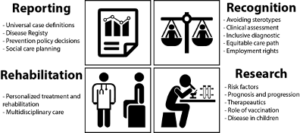By Marija Djekic-Ivankovic & Mariana Gisela Bego
According to a recent viewpoint in Science, around one in three people with symptomatic COVID-19 still experience symptoms 12 weeks after the onset of infection, an outcome known as Post-COVID Conditions or Long COVID. While the mechanisms at play and risk factors of Long COVID are not yet well understood, policy responses need to take into account the complexity of long COVID. In addition, the public health response to COVID-19 needs to adequately address the long-term effects of SARS-CoV-2 infection in the context of the ongoing endemic. Strategies must be formulated to provide integrated care to those suffering from this chronic long-term illness.
Long COVID, also known as Post COVID Conditions, is currently an umbrella term that includes a variety of symptoms. The debilitating symptoms are wide-ranging, multisystemic, and may wax and wane or even worsen over time. The author argues that addressing Long COVID requires long-term planning, and must be approached with humility, open-mindedness, compassion, and scientific rigor. In addition, she suggests that efforts to investigate Long COVID further offer opportunities to better understand its mechanisms and ultimately, offer better outcomes for patients. To do this, she concludes that a more systematic response is required; this includes better reporting, recognition, and rigorous research. Given the complexity of the virus’ post-infection effects, the true picture of Long COVID can only be ascertained through a multidisciplinary approach. The author suggests that an adequate response should incorporate the four Rs: Reporting, Recognition, Rehabilitation, and Research (see Figure 1).

Figure 1. The four Rs needed to properly address Long Covid response: Reporting, Recognition, Rehabilitation, and Research.
Alwan NA, The road to addressing Long Covid. Science 373 (6554), 491-493, 2021. DOI: 10.1126/science.abg7113

